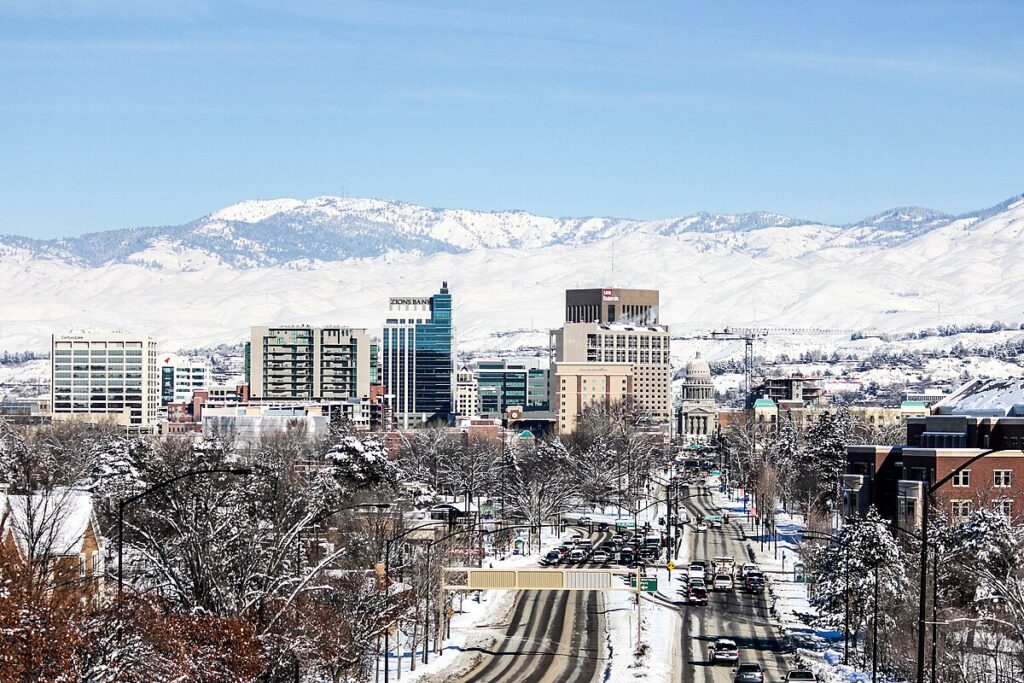
Moving to Boise, Idaho: A Comprehensive Relocation Guide
Considering moving to Boise, Idaho? This booming capital city offers outdoor recreation, tech growth, and quality of life. With approximately 240,000 residents in 2025 (metro 775,000+), Boise combines mountain town atmosphere with urban amenities and the Treasure Valley’s thriving hub.
Demographic Profile to Consider If Moving to Boise:
Boise’s 2025 population is approximately 240,000 residents, with the metro area exceeding 775,000, making it Idaho’s largest city and one of America’s fastest-growing metros. The median age is around 37 years, with young professionals, families, outdoor enthusiasts, and tech workers. The population is approximately 82% White, 8% Hispanic, 4% Asian, 2% Black or African American. Boise features a revitalized downtown along the Boise River, the North End’s tree-lined historic neighborhoods, new developments throughout the valley, and the Boise Foothills providing immediate mountain access. The city attracts transplants from California, Washington, and across America seeking quality of life, outdoor recreation, and growing economy. Boise appeals to tech professionals, outdoor enthusiasts, and families seeking mountain west lifestyle with urban convenience. The community balances explosive growth with preserving livability and access to nature. Find trusted local services for moving, living, and working in Boise.Boise Relocation Directory
Cost of Living to Consider If Moving to Boise:
Boise offers moderate to upper-moderate costs that have risen dramatically with explosive growth. Median home values range from $480,000 to $650,000 in 2025, reflecting massive demand from transplants though cooling from peak pricing. The median household income is approximately $72,000. Rental properties average $1,600 to $2,400 monthly. Idaho’s state income tax is flat 5.8%. Overall cost of living has increased substantially though remains lower than West Coast metros. Boise attracts tech workers, remote workers with California salaries, and those seeking value compared to Seattle or California while maintaining mountain lifestyle. Housing costs reflect explosive demand from migration with inventory challenges. The combination of jobs, outdoor recreation, and livability drives pricing despite growth pains.
Economy and Job Market:
Boise’s economy booms with technology, healthcare, government, and manufacturing. Major employers include Micron Technology (semiconductor manufacturing employing thousands), St. Luke’s Health System, Idaho State government, Boise State University, Albertsons Companies headquarters, and hundreds of tech companies. The technology sector explodes with startups and established companies choosing Boise for talent and lifestyle. Healthcare institutions provide extensive employment. Government as state capital creates jobs. Manufacturing and distribution facilities operate throughout the valley. Typical industries include technology, healthcare, government, manufacturing, and professional services. The diverse economy provides opportunities across sectors with tech growth driving development. The job market attracts professionals seeking career opportunity with outdoor lifestyle.
Education:
Boise School District, West Ada School District, and other districts serve Boise-area students with schools including Boise High School, Timberline High School, and numerous elementary and middle schools. School quality varies requiring family research. Boise State University offers comprehensive programs and NCAA Division I athletics (blue turf football field). The university creates college-town atmosphere and graduates talent feeding local economy. Private schools serve families throughout the valley. The educational infrastructure supports the rapidly growing population.
Recreation and Lifestyle:
Boise offers unparalleled outdoor recreation access with the Boise Foothills providing 190+ miles of trails for hiking, mountain biking, and trail running minutes from downtown. The Boise River Greenbelt features 25 miles of paved paths connecting parks throughout the city. Residents enjoy skiing at Bogus Basin (45 minutes), whitewater sports, fishing, camping, and mountain activities. Downtown Boise features restaurants, breweries, and the Idaho State Capitol. The Basque Block celebrates the area’s Basque heritage. Table Rock offers iconic views. Residents access world-class recreation in Sun Valley, Craters of the Moon, and Idaho wilderness within day trips. Professional sports include Boise State Broncos football. The lifestyle emphasizes outdoor activities, craft beer culture, work-life balance, and active living. The four distinct seasons enable varied recreation year-round. The community values outdoor access, quality of life, entrepreneurship, and maintaining livability despite growth. Living in Boise means embracing growth (traffic increases, housing challenges, changing character), accepting that it’s not the small mountain town it once was, and prioritizing outdoor lifestyle with career opportunities.
Healthcare and Services:
Boise residents access comprehensive healthcare through St. Luke’s Health System with multiple hospitals, Saint Alphonsus Health System, and extensive medical facilities. The region’s healthcare infrastructure provides quality medical care with specialized services. The concentration of medical facilities supports the growing population.
Transportation:
Boise benefits from Interstate 84, Interstate 184, and various corridors. Boise Airport (BOI) provides extensive domestic flights. Valley Regional Transit operates bus routes throughout Boise and the Treasure Valley. Most residents use personal vehicles. Downtown offers some walkability. Bike infrastructure improves continuously. Typical commute times within the metro range 20-40 minutes with traffic increasing as the valley grows.
Conclusion:
Moving to Boise in 2025 offers booming mountain city living with tech growth, outdoor paradise, and quality of life. The city’s combination of Foothills trails, growing economy, and four-season recreation makes it ideal for tech professionals, outdoor enthusiasts, and families seeking mountain west lifestyle where career opportunity meets wilderness access and explosive growth creates both opportunity and challenges in America’s hottest relocation destination.

